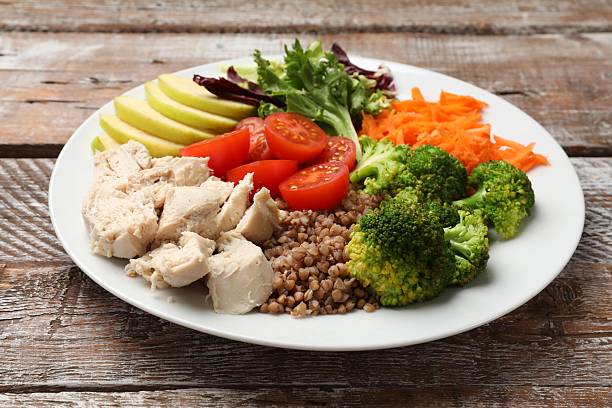
TL;DR:
- Post-surgery diet involves four phases: clear liquids, full liquids, soft foods, and solid foods.
- Clear liquids (Days 1-3) include water, herbal tea, clear broth, sugar-free gelatin, electrolyte drinks, ice chips or sugar-free ice pops.
- Full liquids (Days 4-7), aim for 60 grams protein daily, using protein shakes, blended oatmeal, cream soups, milk, Greek yogurt, vegetable puree, and sugar-free pudding.
- Soft foods (Weeks 2-4), 500-700 calories daily from foods like scrambled eggs, shredded chicken/fish, tofu, cottage cheese, mashed vegetables, and mashed fruits.
- Regular foods (Week 5 and beyond) include small, frequent, healthy meals like grilled chicken with vegetables, ground turkey with sweet potatoes, omelets with spinach, lentil soup, and brown rice with fish.
- It’s recommended to follow diet phases to keep stomach in check, minimize risks, and support long-term weight maintenance. Avoid skipping stages to prevent complications.
—
So, you’ve made the brave choice for bariatric surgery, a life-changing step towards better health. But what comes next? Dive into the world of post-surgery diets with us at Nevada Surgical. I’m Dr. Kent Sasse, and I’ll guide you through essential steps to ensure your recovery is smooth. From understanding the necessary dietary phases to learning which foods support rapid healing, we’ll ensure you feel mentally comfortable and well-informed about your journey. Join us as we explore how to follow post-surgery diet guidelines correctly, setting the stage for your new, healthier life.
Essential Dietary Phases After Surgery
What should you eat after surgery?
After surgery, a phased diet aids healing and ensures safety. Here’s how to progress: clear liquids, full liquids, soft foods, and solid foods. Each stage is crucial for healing and must be followed carefully.
—
Stage One: Clear Liquids (Days 1–3)
Right after surgery, your body needs fluids. Clear liquids are gentle on the stomach and hydrate you without strain.
Clear Liquid Options:
- Water
- Herbal tea (no caffeine)
- Clear broth
- Sugar-free gelatin
- Electrolyte drinks
- Ice chips or sugar-free ice pops
Why it’s important:
It hydrates and starts your recovery without risks. It allows your stomach to adjust after surgery, especially bariatric. Start with small sips to avoid nausea and swelling.
Stage Two: Full Liquids (Days 4–7)
Now, you introduce thicker liquids. These provide more nutrition while still being easy on your gut.
Full Liquid Foods:
- Protein shakes
- Blended oatmeal
- Cream soups (strained, low-fat)
- Milk (lactose-free)
- Greek yogurt (plain, blended with water)
- Vegetable puree
- Sugar-free pudding
Portion Tips:
Drink half a cup per meal, aiming for 60 grams of protein daily to aid healing.
Stage Three: Soft Foods (Week 2–4)
You can start eating soft, moist foods. Chew well and eat slowly to avoid issues.
Soft Food Options:
- Scrambled eggs
- Shredded chicken or fish
- Tofu (silken or baked)
- Cottage cheese
- Mashed vegetables
- Mashed banana or pear
Why it matters:
These foods help your gut return to normal function and support muscle repair. Aim for 500 to 700 calories daily, focusing on protein.
Stage Four: Regular Foods (Week 5 and Beyond)
This is the long-term phase where solid foods are reintroduced. Meals should be small, frequent, and healthy.
Solid Food Examples:
- Grilled chicken with vegetables
- Ground turkey with sweet potatoes
- Omelet with spinach
- Lentil soup
- Brown rice with fish
Avoid:
- Raw veggies
- Fried foods
- Tough meats
- Nuts and seeds
- Fruit skin
Goal:
Maintain small portions and prioritize protein. Avoid snacking and stay disciplined in your meal choices to keep your weight off long-term.
How Long to Stay in Each Stage
Transitioning from one phase to another should be gradual and according to your doctor’s advice. Usually, clear liquids last 2–3 days, full liquids about a week, soft foods 2–3 weeks, and then regular foods.
The Benefits of Bariatric Surgery
Following the dietary plan keeps your new stomach in check. It minimizes risks like leaking or swelling and supports long-term weight maintenance. Each stage supports your goals of healing and sustained health improvements.
Clinical Guidelines and Goals
Clinical Nutrition Guidelines
Trust advice from experts like the Academy of Nutrition and Dietetics and AORN, which stress the importance of hydration, protein intake, and gradual calorie increase. Seeing a dietitian for follow-ups is crucial to prevent setbacks.
Goals of Each Stage
- Clear Liquids: Hydrate and let the gut rest.
- Full Liquids: Begin healing and boost energy.
- Soft Foods: Reintroduce digestion and aid tissue growth.
- Regular Foods: Support health changes and maintain weight loss.
Consequences of Skipping Steps
Skipping these diet phases can lead to complications like stomach pain, swelling, or leaks. Progress carefully through each stage for the best results.
Conclusion
These diet phases, designed with the benefits of surgery in mind, offer a structured way to adapt post-surgery. They promote healing, energy, and sustained weight management, ensuring that the results of your surgery are long-lasting and effective. Follow this plan diligently to achieve your best health outcomes.
##Conclusion
Post-surgery diets are crucial for healing and overall success. We’ve covered the progression from clear liquids to regular foods, focusing on nutrition that boosts recovery. You know which foods help heal, reduce swelling, and should be avoided. Good hydration supports every step and aids in recovery. Follow these expert guidelines and adjust your diet as your healing progresses. Use this knowledge to make choices that support your health. Remember, you can always reach out to me for more personalized advice on your journey to recovery.